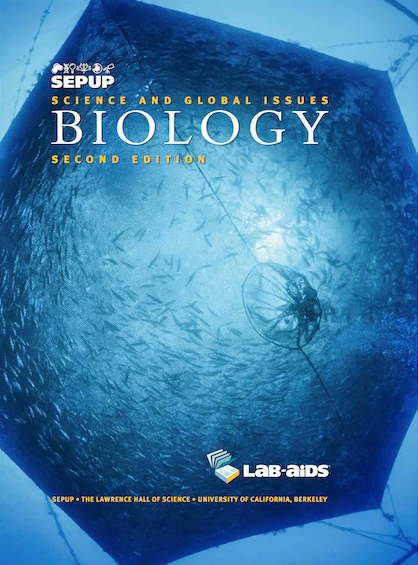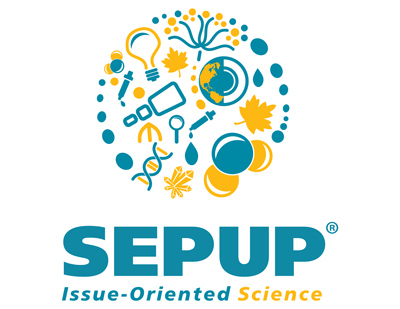Science & Global Issues (SGI)

Science & Global Issues (SGI) is SEPUP’s latest standards-based, issue-oriented two-year high school integrated science program. SGI focuses on the role of science in addressing the needs of modern society and the use of technology in advancing scientific knowledge. This program was recently field tested at a variety of national sites.
SGI includes a year of high school biology and a year of physical science. The one-year biology sequence, titled Science & Global Issues: Biology, was published in early 2011 and is now available from Lab-Aids.
This material is based upon work supported by the National Science Foundation under Grant No. 0352453. Any opinions, findings, and conclusions or recommendations expressed in this material are those of the author(s) and do not necessarily reflect the views of the National Science Foundation.

Sample Activity
Below is a sample activity from our Genetics unit:
Activity #17 – Student Book
Activity #17 – Teacher’s Edition
Overview
Below are descriptions of the science content and issue in each of the five units in this course: Sustainability, Ecology, Cell Biology, Genetics, and Evolution. You can also download a PDF of a table the summarizes the content and issue of each unit:
Sustainability
One of the most critical global issues of our time is how to live in ways that will sustain our planet’s systems and resources. In this introductory unit to Science and Global Issues, you will investigate what it means to live in a sustainable world. You may be familiar with the term “sustainability” and perhaps have heard it used in different contexts. As you will discover in this unit, investigating sustainability often raises more questions than it can answer. Most sustainability problems are a result of people’s overuse and misuse of the earth’s resources. The environmental, economic, and social consequences of unsustainable practice affect us on all levels—individually, locally, and globally. In this unit, you will identify sustainability challenges in towns, countries, and larger regions around the world. You will learn about communities that have applied scientific knowledge and technology to address their local resource challenges. You will estimate the impact of your own lifestyle on the ecological sustainability of the planet. Finally, you will apply the fundamentals of scientific inquiry to investigate a city facing a sustainability dilemma. The evidence gathered will then be used to suggest a course of action for the community.
Ecology
Our world holds an amazing variety of organisms living in all sorts of environments. Organisms affect their environments, and in turn the environment affects them. Understanding the complex web of relationships within ecosystems is essential to understanding their sustainability. Humans interact with ecosystems in many ways. We rely on ecosystems to supply us food, shelter, energy, and the oxygen we breathe. As we consume resources and discard our wastes, we change ecosystems and sometimes threaten their sustainability. In this unit you will examine a variety of ecological issues including the impact of human activities on ecosystems. You will see what can happen when people cause pollution in an area vital to nonhuman and human organisms. You will learn about invasive species and their impacts on established ecosystems. You will also investigate how different management strategies affect the sustainability of fisheries. Finally, you will suggest actions humans can take to help sustain ecosystems for the future.
Cell Biology
All organisms are susceptible to disease. The effects of diseases vary from mild to devastating and affect sustainability at the environmental, economic, and social level. For example, foot-and-mouth and mad cow diseases have periodically wiped out huge herds of cattle, causing economic hardship for those whose livelihoods depend on the cattle. Influenza pandemics have killed millions of people, and recent epidemics of H1N1 and SARS viruses have threatened entire cities.
Diseases are caused by infectious microbes, such as bacteria and viruses, genetic factors, and other events that cause breakdowns in the structure or function of cells. Understanding the mechanisms of a disease is essential to people’s ability to prevent, eradicate, and cure it and to maintain the sustainability of populations and communities.
In this unit, you will examine several diseases and their social, environmental, and economic consequences. You will learn about the mechanism of these diseases at the cellular level. You will also investigate the structures and functions of normal cells and some of the processes that occur inside these cells. At the end of the unit, you will make recommendations for how best to allocate limited funding to address world health problems.
Genetics
For thousands of years, people have selected crops and animals with desirable traits and have bred them to produce ever more desirable offspring. This selective breeding has produced modern varieties of organisms, such as sweet corn, dairy cows, and domestic pets. It was not until the mid-19th century that scientists began to understand that inherited traits pass from parents to offspring through genes. Modern scientists study genetics to learn more about how genes work and to solve such practical problems as enhancing crop productivity, curing diseases, and producing new fuels.
One dynamic, and sometimes controversial, technology that has emerged from genetics is genetic modification. After learning to manipulate the genes of various species, scientists now can place genes from one species into another to give the target species a specific, desirable trait, such as pest resistance. However, many people and some scientists are concerned that this may lead to unintended consequences for the environment and/or human health.
In this unit, you will investigate how genes and patterns of inheritance function in organisms and generations of organisms. You will also learn about the procedures and results of genetic modification and about some of the benefits and trade-offs of producing specific genetically modified organisms.
Evolution
There is great variety within and between the earth’s ecosystems. Each ecosystem differs from others in its varieties of species, genetic makeup of its species, and the evolutionary relationships of species. All of these levels of variation comprise the earth’s biodiversity.
This biodiversity is the product of billions of years of evolution. Ecologists and evolutionary biologists study the evolutionary processes that produce biodiversity, what caused the subtle and dramatic shifts that occurred in the past, and how biodiversity might change in the future. Conservationists often focus on understanding the biodiversity of an area in order to establish priorities for conservation of species. They and other scientists are also concerned with how human activities affect biodiversity.
In this unit, you will investigate the levels of biodiversity and the evolutionary processes that increase, decrease, or maintain biodiversity. You will also examine humans’ social, environmental, and economic influences on biodiversity, and make recommendations for which forest area on a fictitious island should receive funds for conservation.

